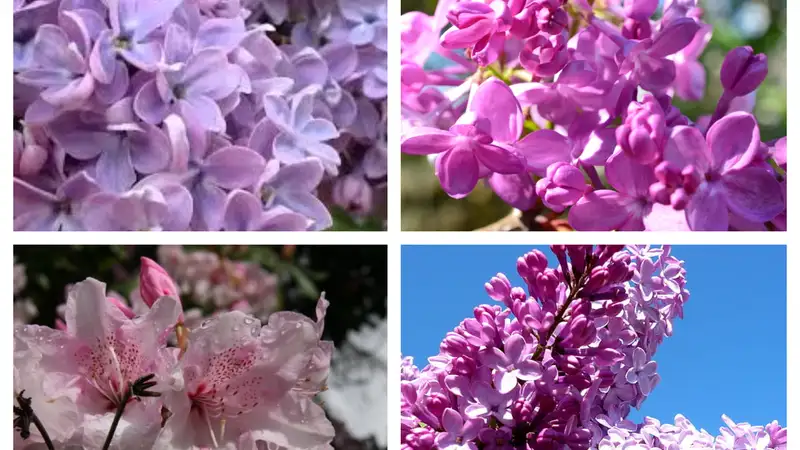Washington Lilacs: The Blossoms of the Evergreen State
Washington, renowned for its stunning natural beauty, boasts a diverse range of flora that contributes to its picturesque landscapes. Among these, the lilac flower holds a special place. With their vibrant hues and enchanting fragrance, lilacs are a beloved feature in many gardens and public spaces across the state.
A Floral Favorite: The Lilac
Among the many beautiful blooms that grace gardens and landscapes, the lilac flower stands out as a timeless favorite. Beloved for its captivating fragrance and stunning array of colors, lilacs have a special place in the hearts of gardeners and flower enthusiasts alike. This deciduous shrub, belonging to the genus Syringa, is not only a symbol of spring but also a testament to the enduring appeal of nature’s beauty.
The Enchantment of Lilacs
Lilacs are celebrated for their large, cone-shaped flower clusters, which bloom in a spectrum of colors including purple, lavender, blue, pink, white, and even yellow. These vibrant blossoms typically emerge in late spring, filling the air with their sweet, heady fragrance. This enchanting scent has made lilacs a popular choice for perfumes and scented products, further cementing their place in horticultural history.
Historical Significance
The lilac’s journey to becoming a garden staple is a storied one. Originating in the rocky hills of the Balkan Peninsula, lilacs were brought to Western Europe by Ottoman traders in the 16th century. Their popularity quickly spread, and by the 18th century, lilacs had become a common feature in European and American gardens. Today, they are cherished worldwide for their beauty and fragrance.
Varieties of Lilacs
There are numerous varieties of lilacs, each with its unique charm. Some of the most popular include:
Common Lilac (Syringa vulgaris): Known for its robust size and vibrant colors, this variety is a garden classic.
French Hybrid Lilac: These hybrids are celebrated for their larger flower clusters and extended blooming period.
Dwarf Korean Lilac Syringa meyeri Palibin: Ideal for small gardens, this compact shrub offers a profusion of lavender-pink flowers.
Japanese Tree Lilac Syringa reticulata: Unlike its shrub counterparts, this variety grows into a small tree adorned with creamy white flowers.
Growing and Caring for Lilacs
Lilacs are relatively easy to grow, making them a favorite for both novice and experienced gardeners. They thrive in well-drained soil and prefer full sun, although they can tolerate partial shade. Here are some tips for growing and maintaining healthy lilacs:
Planting: Choose a sunny spot with good air circulation. Lilacs do best in slightly alkaline to neutral soil. Plant them in the fall or early spring to give the roots time to establish.
Watering: While lilacs are drought-tolerant once established, they benefit from regular watering, especially during dry spells. Be sure to water at the base to avoid wetting the foliage, which can lead to disease.
Pruning: Pruning is essential for promoting healthy growth and abundant blooms. Remove spent flowers and any dead or diseased branches immediately after the blooming season. This helps encourage new growth and prevents the plant from becoming leggy.
Fertilizing: Lilacs generally do not require heavy fertilization. A light application of compost or a balanced fertilizer in early spring can promote vigorous growth.
Lilacs in Culture
Lilacs are more than just a garden favorite; they hold significant cultural symbolism. In literature and art, lilacs often represent love, beauty, and renewal. In the language of flowers, lilacs convey a message of first love and youthful innocence. Their timeless appeal is celebrated in festivals and events around the world, where communities come together to honor these beautiful blooms.
One notable celebration is the Lilac Festival in Spokane, Washington, which features parades, garden tours, and other festivities. This event underscores the lilac’s role in bringing people together to celebrate the arrival of spring and the beauty of nature.
Ideal Growing Conditions
Lilacs, with their enchanting fragrance and beautiful blossoms, are a delightful addition to any garden. To ensure these stunning shrubs thrive and bloom abundantly, it’s essential to provide them with the ideal growing conditions. Here’s a guide to creating the perfect environment for your lilacs.
Climate
Lilacs prefer a temperate climate and are well-suited to regions with distinct seasonal changes, including cold winters and warm summers. They are hardy in USDA zones 3 through 7. The cold period is crucial as it triggers the flowering process. Lilacs generally need at least a few weeks of temperatures below freezing to produce their best blooms.
Sunlight
Lilacs thrive in full sunlight. They require at least 6 hours of direct sunlight each day to bloom profusely. While they can tolerate partial shade, insufficient sunlight can result in fewer flowers and leggy growth. Choose a sunny location with good air circulation to keep the plants healthy and productive.
Soil
Lilacs prefer well-drained, fertile soil with a neutral to slightly alkaline pH (6.5 to 7.5). Here’s how to prepare the soil:
Drainage: Ensure the soil is well-drained to prevent root rot. If the soil is heavy clay, consider amending it with organic matter or creating raised beds to improve drainage.
Fertility: Incorporate compost or well-rotted manure into the soil before planting to enrich it with nutrients. This helps establish strong root systems and promotes healthy growth.
Watering
Lilacs need consistent moisture, especially during their first few years while they are establishing their root systems. Here are some watering tips:
Frequency: Water young lilacs regularly, ensuring the soil stays moist but not waterlogged. Once established, they are relatively drought-tolerant but will benefit from supplemental watering during dry spells.
Method: Water at the base of the plant to keep the foliage dry and reduce the risk of fungal diseases. Deep watering is preferable to encourage deep root growth.
Planting
When planting lilacs, follow these steps to give them the best start:
Timing: Plant lilacs in the fall or early spring. This timing allows the roots to be established before the growing season begins.
Spacing: Space lilac bushes about 5 to 15 feet apart, depending on the variety and mature size, to ensure good air circulation and prevent overcrowding.
Depth: Dig a hole twice as wide and just as deep as the root ball. Place the lilac in the hole, ensuring that the top of the root ball is level with the soil surface. Backfill with soil and water thoroughly.
Mulching
Applying mulch around lilacs helps conserve moisture, regulate soil temperature, and suppress weeds. Use organic mulch, such as wood chips or straw, and spread it in a 2 to 4-inch layer around the base of the plant, keeping it a few inches away from the trunk to prevent rot.
Pruning
Proper pruning is essential for maintaining the health and shape of lilac bushes and encouraging abundant blooms. Here’s how to prune lilacs:
Timing: Prune immediately after the flowering period, typically in late spring or early summer. This timing allows the plant to set buds for the next season.
Technique: Remove spent flowers and any dead or diseased wood. Thin out overcrowded branches to improve air circulation and light penetration. Cut back about one-third of the oldest branches to the ground each year to rejuvenate the plant.
Fertilizing
Lilacs do not require heavy fertilization. A light application of a balanced, slow-release fertilizer in early spring can help promote vigorous growth and blooming. Avoid high-nitrogen fertilizers, as they can lead to excessive foliage growth at the expense of flowers.
By providing these ideal growing conditions, your lilacs will flourish, rewarding you with their captivating blooms and delightful fragrances year after year. Whether you’re an experienced gardener or a novice, following these guidelines will help you create a thriving lilac display in your garden
Varieties in Washington
Washington State, with its temperate climate and fertile soil, is an ideal location for growing a variety of lilac species and cultivars. Here are some of the most popular and well-suited varieties of lilacs that flourish in Washington gardens:
Common Lilac (Syringa vulgaris)
Description: The Common Lilac is the quintessential lilac variety, known for its large, fragrant flower clusters that come in shades of purple, pink, and white.
Ideal Conditions: Prefers full sun and well-drained soil. This variety is hardy and can tolerate the cold winters of Washington, ensuring a robust bloom in late spring.
Popular Cultivars:
Charles Joly’: Deep purple-red, double flowers with a strong fragrance.
Krasavitsa Moskvy’: Also known as ‘Beauty of Moscow,’ this cultivar features double white flowers with a pink tinge.
French Hybrid Lilac (Syringa vulgaris hybrids)
Description: French Hybrid Lilacs are known for their larger and more profuse blooms compared to the Common Lilac. They come in a wide range of colors and often have a longer blooming period.
Ideal Conditions: Similar to Common Lilac, these hybrids thrive in full sun and well-drained soil.
Popular Cultivars:
President Grevy’: Produces large, double blue flowers.
Mme. Lemoine’: Offers double white flowers with a rich fragrance.
Dwarf Korean Lilac Syringa meyeri Palibin
Description: This compact shrub is perfect for smaller gardens or container planting. It produces an abundance of small, lavender-pink flowers with a sweet fragrance.
Ideal Conditions: Grows well in full sun to partial shade and prefers well-drained soil. It is very hardy and can tolerate a range of soil conditions.
Notable Features: Its compact size makes it an excellent choice for urban gardens, patios, and small spaces.
Japanese Tree Lilac (Syringa reticulata)
Description: Unlike the more common shrub form, the Japanese Tree Lilac grows into a small tree, reaching heights of up to 25 feet. It produces creamy white flowers that bloom later in the season, typically in early summer.
Ideal Conditions: Prefers full sun and well-drained soil. It is hardy and can withstand the diverse climate of Washington.
Popular Cultivars:
Ivory Silk’: Known for its large, creamy white flower clusters and compact tree form.
Summer Snow’: Features abundant white blossoms and a strong, pleasant fragrance.
Persian Lilac Syringa x persica
This smaller variety is a hybrid of the Common Lilac and the Afghan Lilac. It produces a dense array of light purple to pink flowers and has a more delicate appearance.
Ideal Conditions: Thrives in full sun and well-drained soil. It is less hardy than some other varieties, preferring milder winters.
Notable Features: Its smaller size and fine-textured foliage make it ideal for borders and smaller garden spaces.
Preston Lilac Syringa x prestige
Description: A hybrid variety developed in Canada, the Preston Lilac is known for its late blooming period, typically in late spring to early summer. The flowers are usually pink, purple, or white.
Ideal Conditions: Prefers full sun and well-drained soil. It is very hardy and can tolerate the cold winters and late frosts of Washington.
Historical and Cultural Significance
Lilacs, known for their enchanting fragrance and vibrant blooms, carry rich historical and cultural significance that spans centuries and continents. From ancient legends to modern festivals, lilacs have left an indelible mark on human culture.
Historical Roots
The history of lilacs begins in Eastern Europe and Asia. Native to the Balkan Peninsula, lilacs were cultivated and appreciated by ancient civilizations for their beauty and fragrance. They made their way to Western Europe in the 16th century, brought by traders traveling along the Silk Road.
In 1563, the lilac was introduced to Europe by the Ottoman Empire, where it quickly gained popularity. The first documented planting of lilacs in Europe was in the gardens of Emperor Rudolf II in Vienna. By the 17th century, lilacs had spread to England and France, becoming a favorite among royal and public gardens alike.
Lilacs in America
Lilacs were introduced to North America by early European settlers in the 18th century. George Washington and Thomas Jefferson were among the notable figures who cultivated lilacs in their gardens. By the 19th century, lilacs had become a staple in American gardens, symbolizing the arrival of spring and the renewal of life.
Symbolism and Meaning
Lilacs have been imbued with various symbolic meanings across different cultures and historical periods. Here are some of the most significant
Love and Romance: In the language of flowers, lilacs are often associated with love and romance. The purple lilac symbolizes the first emotions of love, while white lilacs represent purity and innocence.
Renewal and Spring: Lilacs bloom in late spring, heralding the arrival of the new season. This association with springtime makes them symbols of renewal and regeneration.
Memory and Remembrance: In some cultures, lilacs are used to commemorate the memory of loved ones who have passed away. Their enduring blooms serve as a reminder of eternal love and memory.
Cultural Celebrations
Lilacs are celebrated in numerous festivals and events around the world, highlighting their importance in cultural traditions. One of the most notable is the annual Lilac Festival in Spokane, Washington. This event, which began in 1938, features parades, garden tours, and various community activities, drawing thousands of visitors each year to celebrate the beauty of lilacs.
Another significant celebration is the Rochester Lilac Festival in New York, held in Highland Park. This 10-day event showcases over 500 varieties of lilacs and attracts visitors from across the globe. It includes live music, arts and crafts, and a variety of family-friendly activities.
Lilacs in Art and Literature
Lilacs have inspired countless artists and writers, becoming a recurring motif in art and literature. In painting, Impressionist artists such as Vincent van Gogh and Claude Monet captured the delicate beauty of lilac blooms in their works. Van Gogh’s painting “Lilacs” (1889) is a testament to the flower’s enduring appeal.
In literature, poets and authors have often referenced lilacs to evoke themes of love, nostalgia, and the passage of time. The American poet Walt Whitman, for instance, used lilacs symbolically in his famous poem “When Lilacs Last in the Dooryard Bloom” to mourn the death of President Abraham Lincoln.
Care and Maintenance
Lilacs are cherished for their beautiful blooms and delightful fragrances, but ensuring they thrive requires proper care and maintenance. Here’s a comprehensive guide to help you keep your lilacs healthy and vibrant.
Planting Lilacs
Choosing the Right Location:
Sunlight: Lilacs need at least 6 hours of direct sunlight daily to bloom profusely. Choose a sunny spot with good air circulation.
Soil: Lilacs prefer well-drained, slightly alkaline to neutral soil (pH 6.5-7.5). Avoid waterlogged areas, as lilacs do not tolerate soggy roots.
Planting Time:
Spring or Fall: Plant lilacs in early spring or fall. This allows them to establish roots before the growing season or winter dormancy.
Planting Steps:
Digging the Hole: Dig a hole twice as wide and just as deep as the root ball.
Preparing the Soil: Mix compost or well-rotted manure into the soil to improve fertility and drainage.
Planting: Place the lilac in the hole, ensuring the top of the root ball is level with the soil surface. Backfill with soil and water thoroughly.
Spacing: Space lilac bushes 5 to 15 feet apart, depending on the variety, to allow for proper air circulation and growth.
Watering
Initial Watering: Water newly planted lilacs regularly to keep the soil moist but not waterlogged.
Established Plants: Once established, lilacs are relatively drought-tolerant but will benefit from supplemental watering during dry spells. Water deeply at the base, avoiding wetting the foliage to prevent disease.
Fertilizing
Timing: Apply a balanced, slow-release fertilizer in early spring.
Type: Use a fertilizer with a higher phosphorus content (middle number) to promote blooming. Avoid high-nitrogen fertilizers, which encourage foliage growth over flowers.
Application: Follow the manufacturer’s instructions for application rates. Spread the fertilizer evenly around the base of the plant, keeping it away from the trunk.
Mulching
Benefits: Mulching helps retain soil moisture, regulate soil temperature, and suppress weeds.
Material: Use organic mulch such as wood chips, bark, or straw.
Application: Spread a 2 to 4-inch layer of mulch around the base of the plant, keeping it a few inches away from the trunk to prevent rot.
Pruning
Proper pruning is crucial for maintaining the health and appearance of lilac bushes and encouraging abundant blooms.
When to Prune:
Post-Bloom Pruning: Prune immediately after flowering, usually in late spring. This prevents cutting off next year’s flower buds.
How to Prune:
Deadheading: Remove spent flower clusters to prevent seed formation and encourage more blooms.
Removing Dead or Diseased Wood: Cut back any dead, damaged, or diseased branches to improve overall plant health.
Thinning: Thin out overcrowded branches to improve air circulation and light penetration. Cut back about one-third of the oldest stems to the ground each year to rejuvenate the plant.
Shaping: Maintain the desired shape and size by trimming back excessively long branches.
Disease and Pest Management
Common Issues:
Powdery Mildew: This fungal disease appears as a white powdery coating on leaves. Ensure good air circulation and avoid overhead watering to prevent it.
Lilac Borer: This pest bores into stems, causing wilting and dieback. Prune and destroy infested branches and use appropriate insecticides if necessary.
Leaf Spot: Fungal spots on leaves can be minimized by maintaining good air circulation and keeping foliage dry.
Preventative Measures:
Sanitation: Remove and dispose of fallen leaves and debris to reduce disease risk.
Proper Spacing: Ensure plants are adequately spaced to improve air circulation.
Winter Care
Protection:
Mulching: Apply a layer of mulch around the base of the plant in late fall to insulate the roots and protect them from freezing temperatures.
Avoid Pruning: Do not prune in late summer or fall, as this can stimulate new growth that is susceptible to winter damage. If you want to know more about these beautiful flowers check my site 101desires.
Conclusion
Washington’s lilacs are more than just a visual delight; they are a testament to the state’s natural beauty and horticultural heritage. Whether you’re a seasoned gardener or a nature enthusiast, the sight and scent of lilacs in bloom are sure to captivate your senses and inspire a deeper appreciation for the wonders of the Evergreen State. From public festivals to private gardens, lilacs continue to bring joy and a touch of elegance to Washington, reaffirming their status as one of the state’s most cherished flowers.



